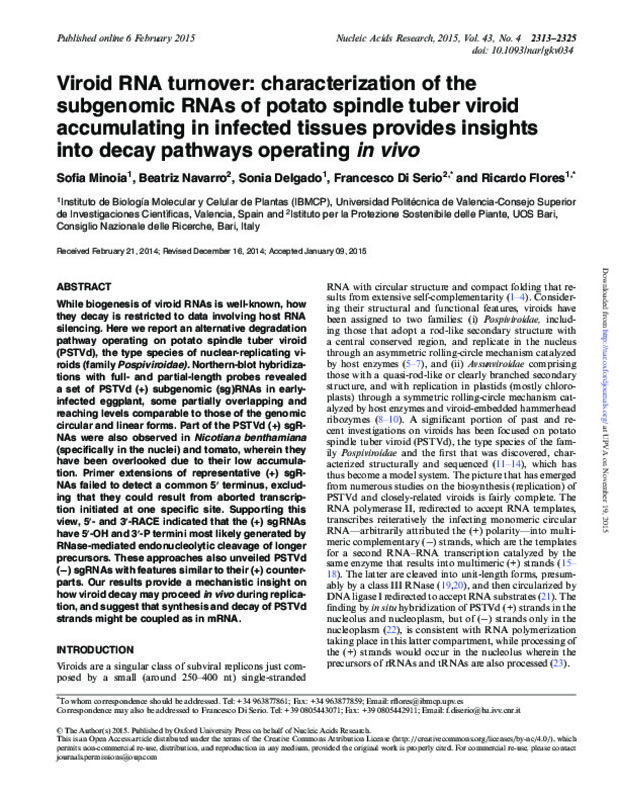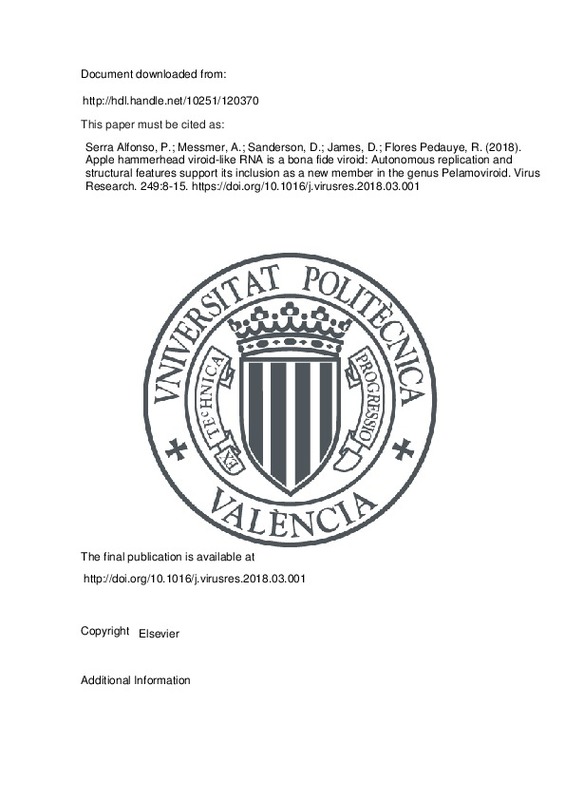JavaScript is disabled for your browser. Some features of this site may not work without it.
Buscar en RiuNet
Listar
Mi cuenta
Estadísticas
Ayuda RiuNet
Admin. UPV
On the early identification and characterization of pear blister canker viroid, apple dimple fruit viroid, peach latent mosaic viroid and chrysanthemum chlorotic mottle viroid
Mostrar el registro sencillo del ítem
Ficheros en el ítem
| dc.contributor.author | Navarro, Beatriz
|
es_ES |
| dc.contributor.author | Ambros, Silvia
|
es_ES |
| dc.contributor.author | Di Serio, Francesco
|
es_ES |
| dc.contributor.author | HERNANDEZ FORT, CARMEN
|
es_ES |
| dc.date.accessioned | 2024-05-16T18:08:50Z | |
| dc.date.available | 2024-05-16T18:08:50Z | |
| dc.date.issued | 2023-01-02 | es_ES |
| dc.identifier.issn | 0168-1702 | es_ES |
| dc.identifier.uri | http://hdl.handle.net/10251/204216 | |
| dc.description.abstract | [EN] In the 90 ' s, pear blister canker viroid (PBCVd), apple dimple fruit viroid (ADFVd), peach latent mosaic viroid (PLMVd) and chrysanthemum chlorotic mottle viroid (CChMVd) were identified and characterized in the Ricardo Flores' laboratory. In these studies, the autonomous replication of these infectious RNAs and their involvement in the elicitation of diseases in their natural hosts were also shown. Their discovery was achieved by classical approaches based on the physical purification of the viroid RNAs from polyacrylamide gels followed by the sequencing of their genomic RNAs and by bioassays to assess their autonomous replication and the fulfillment of Koch's postulates. The molecular characterization of these four viroids, including the study of their sequence variability, contributed to the establishment of the concept of quasispecies for viroids and to the development of reliable molecular diagnostic methods that have facilitated the control of the diseases they caused. Most importantly, some of these viroids became valuable experimental model systems that are still used nowadays to study structural-functional relationships in RNAs and to dissect evolutionary and pathogenic pathways under-lying plant-viroid interaction. The differences between early viroid discovery strategies, relying on biological and pathogenic issues, and the current high-throughput sequencing-based approaches, that frequently allow the discovery of new viroids and viroid-like RNAs in symptomless hosts, is also discussed, clarifying why the traditional molecular and biological studies mentioned above are still required to conclusively define the nature of any novel viroid-like RNA. | es_ES |
| dc.language | Inglés | es_ES |
| dc.publisher | Elsevier | es_ES |
| dc.relation.ispartof | Virus Research | es_ES |
| dc.rights | Reconocimiento - No comercial - Sin obra derivada (by-nc-nd) | es_ES |
| dc.subject | Koch's postulates | es_ES |
| dc.subject | Viroid discovery | es_ES |
| dc.subject | Plant disease | es_ES |
| dc.subject | Apscaviroid | es_ES |
| dc.subject | Pelamoviroid | es_ES |
| dc.subject | Quasispecies PBCVd ADFVd PLMVd,CChMVd | es_ES |
| dc.title | On the early identification and characterization of pear blister canker viroid, apple dimple fruit viroid, peach latent mosaic viroid and chrysanthemum chlorotic mottle viroid | es_ES |
| dc.type | Artículo | es_ES |
| dc.identifier.doi | 10.1016/j.virusres.2022.199012 | es_ES |
| dc.rights.accessRights | Abierto | es_ES |
| dc.description.bibliographicCitation | Navarro, B.; Ambros, S.; Di Serio, F.; Hernandez Fort, C. (2023). On the early identification and characterization of pear blister canker viroid, apple dimple fruit viroid, peach latent mosaic viroid and chrysanthemum chlorotic mottle viroid. Virus Research. 323. https://doi.org/10.1016/j.virusres.2022.199012 | es_ES |
| dc.description.accrualMethod | S | es_ES |
| dc.relation.publisherversion | https://doi.org/10.1016/j.virusres.2022.199012 | es_ES |
| dc.type.version | info:eu-repo/semantics/publishedVersion | es_ES |
| dc.description.volume | 323 | es_ES |
| dc.identifier.pmid | 36436691 | es_ES |
| dc.identifier.pmcid | PMC10194241 | es_ES |
| dc.relation.pasarela | S\513634 | es_ES |











